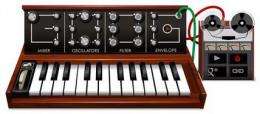Play on: Google posts synthesizer tribute to Moog

(AP) -- Bob Moog's synthesizer helped change the sound of modern music. On what would have been his 78th birthday, Google is paying tribute to the man with a virtual version of his famous Moog on their homepage - and it's completely playable.
The Moog doodle, a replica of the Minimoog Model D, may not be a highly complex synthesizer but it explores a lot of the realms of synthesis - the sculpting of sound mastered by a synthesizer.
"To be able to put all those capabilities in the hands of hundreds of millions of people is just astounding," said Moog's daughter Michelle Moog-Koussa, who serves as executive director of the Bob Moog Foundation. "I think he would be humbled and awed."
In 45 years, the Moog synthesizer has gone from a behemoth instrument that took several techs to work and several people to carry, to one you can download on your iPhone.
Moog's first modular synthesizers in the mid- to late-'60s could easily weigh between 70 and 100 pounds. Keith Emerson's monster Moog, for example, is more than 200 pounds. Moog's early synths were high-maintenance and finicky. Sometimes they wouldn't work in the heat, other times the oscillators would drift.
They were built on a workbench, using transistors, resistors, capacitors, lots of wires and a soldering iron.
"It was definitely a hardware venture," said Moog-Koussa.
Moog's first modular synths were built for experimental composers looking for new sounds to explore. Eventually, they found their way into the mainstream.
The Doors and Monkees were early adopters, but it was Wendy Carlos' 1968 record, "Switched-on Bach" that showcased the true sonic possibilities of the monolithic instruments.
Moog responded to the increased demand by releasing the Minimoog, which could be put in a case and carried. Though they were more portable and accessible, they still remained out of reach for many musicians given their high price tag. A Minimoog today, for example, costs more than $3,000.
The advent of computers and mobile devices has given way to a number of cheaper alternatives from Moog and other companies - virtual synthesizers that are built not on workbenches, but on computers by programmers using code.
Animoog, the Moog company's most recent iPhone app, costs $0.99 And, if that's still too much for you, there's always the free Google doodle.
©2012 The Associated Press. All rights reserved. This material may not be published, broadcast, rewritten or redistributed.




















